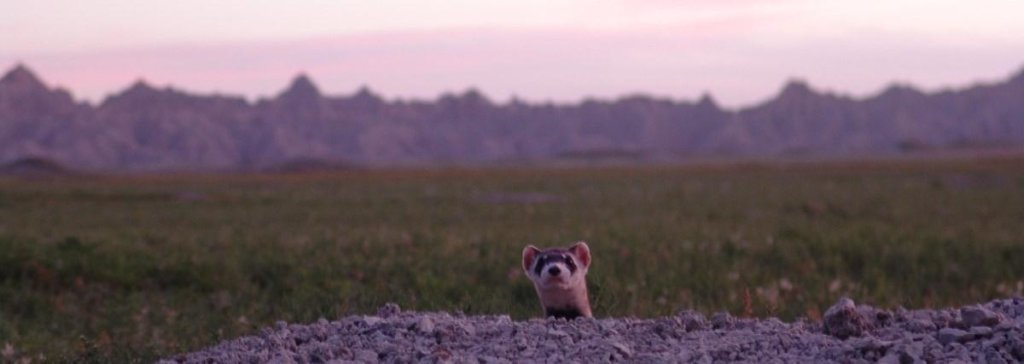It’s Not Easy Being A Black-Footed Ferret
by Will Martin
Broadcast 8.18 & 8.21.2020

Black-footed ferret, Badlands National Park, SD. Photo: NPS, public domain.
Listen:
When most people think of the threatened or endangered species of Montana, they tend to focus on the iconic animals of the West: the grizzly bear, the wolf, or the Canadian lynx. But there’s far less attention placed on the rarest Montana mammal and the only ferret species endemic to North America.
The black-footed ferret once populated the eastern edges of the Rocky Mountains, east to the Dakotas and south to Texas, but can now only be found in a few isolated areas throughout the West. The black-footed ferret has always been a reclusive animal. The famous naturalist John Audubon was the first Euro-American to observe and describe the species in the 1840s. He recorded how the slender body of the ferret allowed them to be effective predators of prairie dogs, with the average family of four consuming 763 prairie dogs per year.
After Audubon’s initial sighting, there wasn’t another one recorded by scientists or naturalists for 25 years. Although rarely seen, the black-footed ferret didn’t start its dramatic decline until the beginning of the 20th century.
Starting in the 1920s, the federal government supported programs to eradicate the prairie dog population – which makes up 90% of the ferrets’ diet – by using poisons, and by plowing prairie dog towns. The loss of the ferrets’ main food source and the conversion of grasslands to agricultural lands led to the dramatic population decline and the species being listed as an endangered species in 1967.
By the late 1970s, it was feared that the black-footed ferret had gone extinct. However, in 1981, a dog killed a specimen of the curious-looking species on a small ranch in Meeteetse, Wyoming, where later, the last hundred thirty black-footed ferrets were found.
In the mid-1980s, canine distemper and sylvatic plague spread through the population, and in 1986, the last 18 known black-footed ferrets were captured and sent to a captive breeding center. The goal of the program was to have 240 breeding peers in captivity before the beginning of reintroduction. And by 1991, this goal was met. To safeguard against the threat of further disease and extinction, the population was reintroduced at multiple sites in Wyoming, South Dakota and Montana.
The black-footed ferret was first reintroduced into Montana in 1994 at the Charles M. Russell National Wildlife Refuge. Then, two years later, thirty-five kits and five adults were released at the Fort Belknap Indian Reservation.
Unfortunately, the introduction did not go as planned. By the end of the year, only eight of the original 40 ferrets could be located. But there were also some signs of hope. That spring, three pairs of the ferrets produced at least five kits. In order to help the fledgling population, an additional 36 ferrets were introduced to the Fort Belknap Indian reservation. Hoping to protect the population, 66 coyotes were eradicated from the surrounding area, and an electric fence was placed around the prairie dog town for a few weeks to deter predators. But that December, a survey of the population recorded only 24 ferrets at the site.
Even with all these precautions, the future of the ferret is still uncertain, and there is growing concern about the genetic diversity of the captive population. In Montana, the goal is to reestablish two viable populations with a minimum of 50 breeding adults in each. Nationwide, the objective is to establish a wild population of fifteen hundred adults in ten or more locations.
The story of the black-footed ferret’s struggle for survival has been one of hope and setbacks. But with more emphasis being placed on conservation in Montana and in the rest of the United States, hopefully the story of the black-footed ferret will ultimately have a happy ending.
Every week since 1991, Field Notes has inquired about Montana’s natural history. Field Notes are written by naturalists, students, and listeners about the puzzle-tree bark, eagle talons, woolly aphids, and giant puffballs of Western, Central and Southwestern Montana and aired weekly on Montana Public Radio.
Click here to read and listen to more Field Notes. Field Notes is available as a podcast! Subscribe on iTunes, Google Play, or wherever you listen to podcasts.
Interested in writing a Field Note? Contact Allison De Jong, Field Notes editor, at adejong [at] montananaturalist [dot] org or 406.327.0405.
Want to learn more about our programs as well as fun natural history facts and seasonal phenology? Sign up for our e-newsletter! You can also become a member and get discounts on our programs as well as free reciprocal admission to 300+ science centers in North America!












